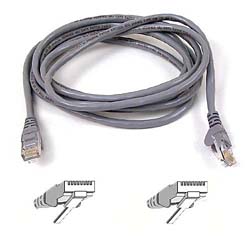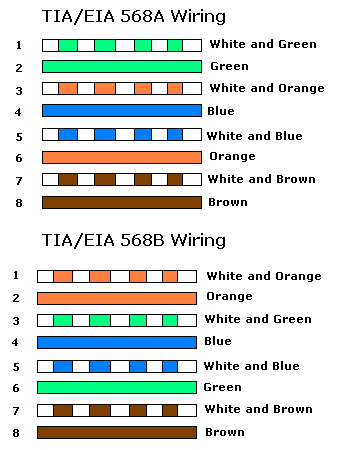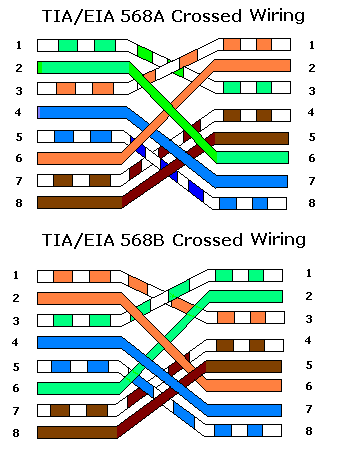
| HOME | TRAINING | SERVICES | BLOG | COMPUTER TIPS | NEWS | CONTACT US |
Transmission Media

Transmission media – The pathway that enables computers to send and receive signals to one another
Physical and Wireless media can connect computers in a network.
Physical Media
Types of Cable Signals
Straight-through cable – The eight wires inside of each RJ45 are in the exact same order (use to connect heterogeneous devices)
(Host to Router, Host to Switch and Switch to Router)
Cross-over cable – The wires 1 & 3, 2 & 6, are reversed (use to connect homogenous devices)
(Host to Host, Switch to Switch and Router to Router)
Rollover or Console cable – It is a special cable use for console access to a switch or router.
Types of Physical Cable Media

Twisted Pair (Solid vs. Stranded)
Twisted Pair Cable uses one or more pairs of twisted copper wires to transmit signals
2 types of twisted pair cables
UTP – Unshielded Twisted Pair (Most common)
STP – Shielded Twisted Pair (Protection against EMI)
Cable, Transfer Speed and Bandwidth
CAT3
10Mbps
16MHz
CAT4
4-16Mbps (Token Ring)
20MHz
CAT5
10/100Mbps
100-350MHz
CAT5e
10/100/1,000Mbps
100-350MHz
CAT6
10/100/1000/10,000Mbps
100-500MHz
CAT6a
10/100/1000/10,000Mbps
500-1000MHz
CAT 7
10/100/1000/10,000Mbps
700-1000MHz
CAT cables usually connect to an RJ45 connector

Straight Thru-Cable (Heterogeneous Environment)

Cross Over Cable (Homogenous Environment)

1 |
2 |
3 |
4 |
5 |
6 |
7 |
8 |
Transmit+ |
Transmit- |
Receive+ |
Not used |
Not used |
Receive- |
Not used |
Not used |
Coaxial
Coaxial cable, commonly called coax, has two conductors that share the same axis.

Coaxial
Thinnet or 10Base2 cost is cheap RG58 wire with 50 Ohms Terminator
Must use a T connector with BNC and last computer on both ends must be terminated
No more than 30 nodes per segment
Nodes must be space 0.5 meters apart
Thicknet or 10Base5 moderate costs RG8 rated at 50 Ohms connects to an AUI or DIX NIC thru a vampire tap
Nodes must be 2.5 meter intervals
No More than 100 Nodes per segment
Use |
Type of Coaxial Cable |
Termination |
Connector |
10Base2 (Thinnet) |
RG58 |
50ohmn |
BNC |
10Base5 (Thicknet) |
RG8 |
50ohmn |
AUI/DIX |
Cable TV |
RG59 (analog) |
75ohmn |
F |

Coaxial Cable
Fiber-Optic
Fiber-Optic cable transmits light signals rather than electrical signals.
Most expensive physical media usually use as backbone or a high speed connection

Multi mode Fiber (MMF) - use LED light emitting diode found on most high speed networks use for shorter distances
Single mode Fiber (SMF) - use Laser to transmit signal mostly for longer distances
Fiber Optic Connectors
![]() ST
ST
![]() SC
SC
![]() MTRJ
MTRJ
 LC
LC
ST – Straight Tip Connector
SC – Square Connector
SFF (Small Form Factor) Fiber Optic connectors
MTRJ- Mechanical Transfer Registered Jack
LC – Local or Lucent Connector
Advantage:
Speed, Distance, Security and Immune to EMI
Disadvantage:
Cost, Difficulty of installation and Flexibility
Transmission Degradation of Physical Media
Attenuation – Loss of signal as it goes to a transmission media.
Crosstalk – a form of EMI caused by wires to interfere next to each other
Dispersion – applies to fiber optic cables.
Fire Ratings - Plenum (Non Flammable fire rating for cables) vs. PVC Poly Vinyl Chloride
Wireless Media

Radio Waves – use radio signals to communicate, the three types of radio waves are low power, high power and spread spectrum broadcasts.

Microwave Transmission - most popular long distance transmissions found in networks. It uses line-of-sight communication.
Microwave systems consist of 2 radio transceivers: one to transmit and one to receive. These antennas are usually installed on towers to give them more distance and speeds.

Infrared- uses infrared light to transmit signals. Infrared signals cannot penetrate walls or other thick objects

Satellite - Uses Satellite Technology to transmit signals. (Direct TV)
Install components of wiring distribution
Distribution Frame
MDF stands for Main Distribution Frame and IDF stands for Independent Distribution Frame.
The MDF is the main computer room for connecting servers, switch, routers, DSL's, etc. to reside.
The IDF is a remote room or closet connected to the MDF. In the IDF you can expect to find hubs and patch panels.

Cross connects - A device that allows conductors or channels to be interconnected, either physically or electronically, on a semi-permanent basis. A cross-connect can be in the form of a main distribution frame (MDF), intermediate distribution frame (IDF), or terminal block where wire pairs from cables are mechanically terminated on a punch-down block, with short wire jumpers interconnecting the cable pairs on each side of the block.
A cross-connect is a location within a cabling systems that facilitates the termination of cable elements plus the reconnection of those elements with jumpers, termination blocks, and/or cables to a patch panel and so on. It’s where all the wires come together
Cables that run from communication closets to wall outlets are known as horizontal cables, because there are generally used on the same floor of building.
Backbone cables that connect equipment rooms, telecommunication rooms and other physical termination points are referred to as vertical cables, because they are often from floor to floor in a building.
A patch panel or patch bay is a panel, typically rack-mounted, that houses cable connections. One typically shorter patch cable will plug into the front side, whereas the back holds the connection of a much longer and more permanent cable. The assembly of hardware is arranged so that a number of circuits, usually of the same or similar type, appear on jacks for monitoring, interconnecting, and testing circuits in a convenient, flexible manner.
The 25-pair color code is a color code used to identify individual conductors in a kind of electrical telecommunication wiring for indoor use, known as twisted pair cables. The colors are applied to the insulation that covers each conductor.
The 100-pair color code is another type of wiring use for telecommunications and networking.
A 66 block (also M-Block) is a type of punch down block used to connect sets of wires in a telephone system.
A 110 block is a type of punch block used to connect sets of wires in a structured cabling system.
A demarc (an abbreviation for demarcation point) marks the point where communications facilities owned by one organization interface with that of another organization.
A demarc extension refers to the process of installing additional wiring from the main connection
In telecommunications, a network interface device (NID) is a device that serves as the demarcation point between the carrier's local loop and the customer's premises wiring.